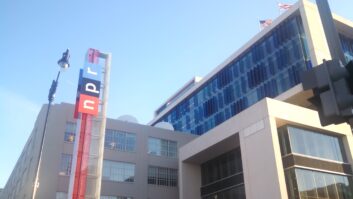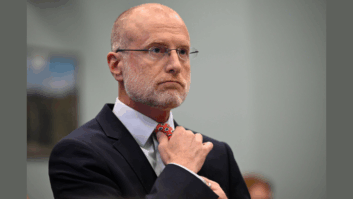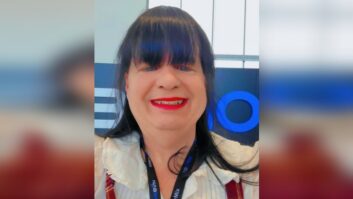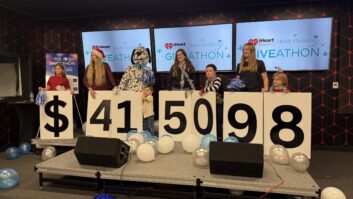
What’s this boat on the beach for? Photo courtesy Medialaan
OSTEND, Belgium — For the 10th consecutive year, Dutch-language commercial radio station Qmusic temporarily moved its studios to the sands of Ostend.
From July 2–Aug. 28, Qmusic hosted live radio at the Q-Beach House, between 10 a.m. and 11 p.m. The station also invited the audience to join the its “Sunset Concerts” staged on the roof of the on-air studio.
The Q-Beach House is located in front of the prestigious Thermen Palace hotel near the center of Ostend and comprised an on-air radio studio and production room, a restaurant/bar and a public seating area with deck chairs and outdoor furniture, all with a seaside view. Behind the 1200-square meter facility, a technical area offers room for the equipment (radio and video) and station staff.
Putting all this together was technically complicated, both in terms of radio connectivity and logistics. A technical team of three engineers started building one week before the opening show.

Rudi Wynants controls the video stream at the
Q-Beach House. Photo by Marc Maes
NO MUSIC
“The remarkable thing about our broadcasts is that we don’t have any music with us,” said Rudi Wynants, Radio Project manager with Medialaan, the parent company of Qmusic and JOE.
“Once the presenter opens a fader on the Studer OnAir 3000 beach house console, the server in our Vilvoorde main studio ignites a full-quality WAV file and sends it off to Ostend — at a speed where neither the DJ nor the audience notice the difference.”
Wynants offered that the process may be somewhat different from other radio stations, but he saw advantage in the fact that the complete functionality of the on-air studio, like scheduling and advertising, remained identical to the one in Vilvoorde. “You could say a radio studio with a remote presenter 100 kilometers away,” he laughed.

Qmusic DJs Elias Smekens, left, and Felice Dekens prepare a presentation in the backstage production room. Photo by Marc Maes
SETUP
The backstage control room offers space for both radio and video equipment. A sturdy audio rack includes the servers and a graphics display monitoring the connection between Ostend and Vilvoorde along with the site’s power consumption.
“In fact, we established a point-to-point link, split in four VLAN connections,” continued Wynants. “The Dalet playout system is our priority VLAN — if, on peak moments, we have excessive data traffic with other applications, the Dalet’s function should be 100 percent flawless.” The link further includes a Studer VLAN,an office VLAN and the visual radio VLAN.
Qmusic’s beach audio package is routed via AoIP to Vilvoorde where a dispatch engineer constantly monitors the on-air signal. In case of technical failure the engineer opens a second audio stream.
“In the worst case scenario, like in case of problems with the [telecom operator] Proximus network, we have a separate (aptX 256 kbps) encoder, multiplexing two ISDN lines. This allows us to get the presenter mic signal to the Vilvoorde studio. The music engineer in Vilvoorde would then take over the self-op from there.”

Qmusic presenter Rik Boey interviews Bob Sinclar before
staging his Sunset Concert. Pictured on the far right is
DJ sidekick Violette Goemans. Photo courtesy Medialaan
Although Qmusic pioneered visual radio years ago, and continues to expand that function, Wynants emphasized that FM radio should remain a top priority. “There’s a golden rule in radio that says radio people should have the option to improvise and seize the moment at all times. This is contradictory to the values and standards of TV production,” Wynants said. “But I do admit that adding image to radio makes the younger audience listen to radio, not via FM but on tablets and smartphones.”
The control room included a full video facility to monitor and control the Q-Beach site’s 11 to 18 cameras plus two Q-Ball remote weatherproof cameras, offering 360-degree images from the stage or the site. The TV signal was embedded with audio and transmitted via a separate connection to Vilvoorde. It was streamed over Qmusic’s webstream and broadcast via the cable network in Flanders.

Milow performing a Sunset Concert on Qmusic’s studio
rooftop stage Photo courtesy Medialaan
SUNSET AND WIND
Another challenge for Qmusic’s technical team were the so-called “Sunset Concerts.” Alongside a daily menu of “pop-up” concerts on the Q-Beach House site, mixing new talent with established artists in front of a live audience, the Ostend beach location also served as an open-air concert venue for the Sunset Concerts.
“These concerts have grown from modest live presentations to full-fledged concerts,” said Wynants. “This year, with concerts by Tourist LeMC, Bazart, Bob Sinclar, Lost Frequencies and Milow, an average attendance of 10,000 music lovers became the new standard.”
“We have the meteorological conditions to cope with,” he continued. “At the seaside (at water level) we generally have wind blowing at least Force 4 on the Beaufort scale. But on the roof of our studio, wind blows even stronger. It’s not a piece of cake to amplify a full band with drums and 10 mics with strong wind conditions. Windshield caps are no solution because they cause rumble in the mics and loose the proximity effect.”
In case of winds stronger than 6 on the Beaufort scale, concerts are cancelled. With a specific crew of 22 people for the audio system, video recording and radio broadcast, Wynants is well aware that the Sunset Concerts are very expensive to produce. But the station says it puts “safety first.” Second Position Qmusic continues to grow — according to the most recent ratings published on Aug. 18by CIM (Centrum voor Informatie over de Media) — the station has climbed to become Flanders’s second most popular station. Preceded only by full-service national broadcaster Radio 2 (27.8 percent audience share), Qmusic posted a 13.4 percent ratings figure (compared to 11.7 percent in the previous ratings results).
Iwan Reuvekamp, radio program director at Medialaan said, “We’re happy with the clear signal given by the Qmusic audience. It’s a solid basis to continue building our long term strategy.”
Qmusic is the only commercial station in the Flemish radioscape’s top 5 — Studio Brussel, MNM and Radio 1 complete the ratings.
The audio signal during the Sunset Concerts was routed both to a main public announcement system and a backstage DiGiCo SD9 mixing console for broadcast purposes. A MADI cable connection streamed the signal from the front of house console to the SD9 desk where a separate radio broadcast mix was routed to the Vilvoorde main studio.
For the amplification of the actual radio signal in the Q-Beach House, a weatherproof audio system was put in place. Wynants opted for a combination of Bose 802 boxes, Bose RoomMatch RMU208 speakers and weather-resistant Bose Panaray MB12 Bass Module subwoofers.
“Placing speakers throughout the beach house site, reduced the sound level yet offered a clear and immersive sound, and the best possible noise reduction to the seaside apartments,” he said.
Qmusic DJs have direct visual contact with the audience, and during specific timeslots, the on-air studio is open to visitors, offering a “radio presenter” view from behind the microphone. TV CHANNEL On Aug. 28 coinciding with the introduction of Qmusic’s new program roster, parent company Medialaan launched Q2, the TV leg of Qmusic.
Q2 broadcasts nationwide on the former 2BE TV frequencies. The link between radio and TV was emphasized when Qmusic presenters Maarten Vancoillie and Dorothee Dauwe kicked off the first Q2 broadcast from Qmusic’s Beach House resort in Ostend.
Q2, in tandem with Qmusic, will focus on the younger generation and carries the same tagline “You make us Q.” The station’s program roster includes a wide choice of comedy, movies and new TV series.
“Qmusic is a very strong brand on the Belgian market with a large daily reach. By creating a TV pillar of the brand under the name Q2, we maximize the synergies between both the content and the experience of the brand. Young people aged 18–34 inspire us everyday to make entertainment that is relevant in their lives — you make us Q,” commented An Caers, marketing and communications manager for Radio
— Marc Maes







